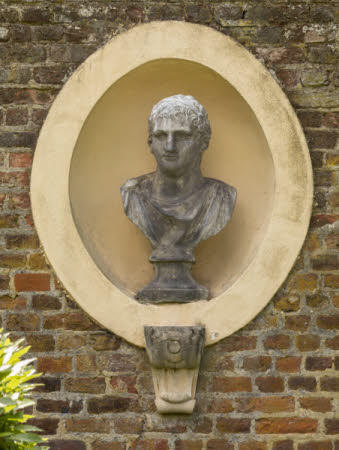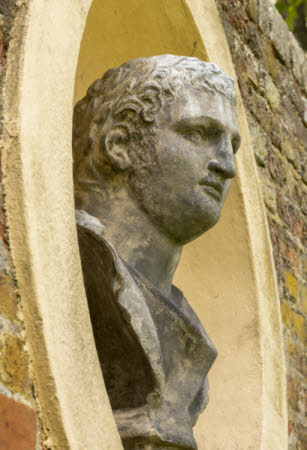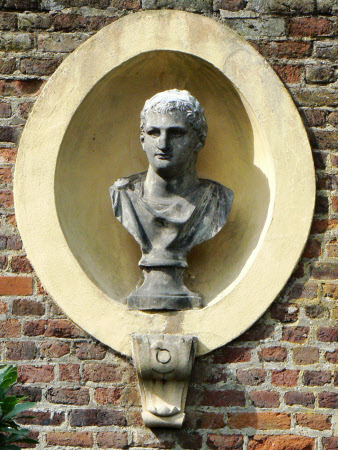Bust of the Roman emperor Nero
workshop of John Besnier (fl.1681)
Category
Art / Sculpture
Date
c. 1670 - 1672
Materials
Lead, Sandstone
Measurements
750 mm (H)435 mm (W)
Place of origin
London
Order this imageCollection
Ham House, Surrey
NT 1140365
Summary
A lead portrait bust of the Roman emperor Nero wearing armour, with a corselet, over which is a cloak. One of thirty-eight lead busts made for the garden walls of Ham House in 1671-72, perhaps in the workshop of John Besnier, thirty-six of which survive in niches on the walls and on the north façade of the house.
Full description
A lead portrait bust of the Roman emperor Nero (A.D. 37-68, reigned 54-68) wearing armour, with a square-necked corselet, over which is a cloak, fastened at the right shoulder with a round brooch. He has a laurel wreath in his hair. Curled hair, long sideburns, he looks slightly to his right. Mounted on a plinth, and placed on a sandstone console carved with circular boss, and below a scrolled tongue. The emperor Nero remains one of the most notorious of all the Roman emperors, although a recent exhibition at the British Museum sought to demonstrate that many of the contemporary reports of Nero’s actions were biased and exaggerated (Thorsten Opper, Nero. The Man Behind the Myth, British Museum, London 2021). Nero was adopted by the Emperor Claudius, whose daughter Octavia he married. Among his instructors was the philosopher Seneca. Among those whom Nero was said to have put to death were the son of Claudius, Britannicus, his mother Agrippina and his wife Octavia, whilst he forced Seneca to commit suicide. Among major events that marked Nero’s reign were the revolt of Boudica (Boadicea) in c. 60-61 A.D. and the great fire that destroyed Rome in 64. A plaster bust on the staircase at Ham House is identified as the emperor Nero through a reversed inscription on the neck, no doubt intended as a guide for the sculptors and left on by mistake. Although the bust sections differ, the heads of the plaster and the two lead portraits are all but identical, suggesting the casts derive from the same master mould. This also helps to confirm that the plaster busts on the staircase were made in the same workshop as the lead busts outside. The source for the portrait of Nero may have been based on a marble bust that was owned by Peter Paul Rubens, and subsequently to the Duke of Buckingham, in whose collection it was recorded in 1635. Its appearance is recorded through a print made by Paulus Pontius after a drawing by Rubens, one of the series of twelve prints by Rubens of famous men from ancient Greece and Rome. The bust is one of two lead busts of the same model at Ham, the other NT 1140338. They would have originally formed part of a sequence of the Twelve Caesars, and are two of thirty-six lead busts displayed in oval niches in the garden walls and on the north façade of Ham House, probably installed in 1671-72, and recorded in the 1679 inventory of Ham House. The entire series was probably arranged in its present positions along the garden walls and on the north front of Ham House by the 6th Earl of Dysart as part of improvements undertaken between 1798 and 1803. The busts may well, like other sculpture at Ham House, have been made in the workshops of the Besnier family, perhaps by John Besnier, who received a commission for lead statuary from the Duke of Ormonde in 1681. For a fuller discussion of the garden wall busts and their history and attribution, see NT 1140335. Jeremy WarrenJanuary 2022
Provenance
Probably made and installed in 1671-72, to the commission of John Maitland and Elizabeth Murray, 1st Duke and Duchess of Lauderdale. Thence by descent,until acquired in 1948 by HM Government when Sir Lyonel, 4th Bt (1854 – 1952) and Sir Cecil Tollemache, 5th Bt (1886 – 1969) presented Ham House to the National Trust. Entrusted to the care of the Victoria & Albert Museum until 1990, when returned to the care of the National Trust, to which ownership was transferred in 2002
Makers and roles
workshop of John Besnier (fl.1681), sculptor
References
Avery 2013: Charles Avery, ‘Seventeenth-century Sculpture at Ham House’ in Christopher Rowell, ed., Ham House. 400 Years of History, New Haven/London 2013, pp. 158-77., pp. 172-76



